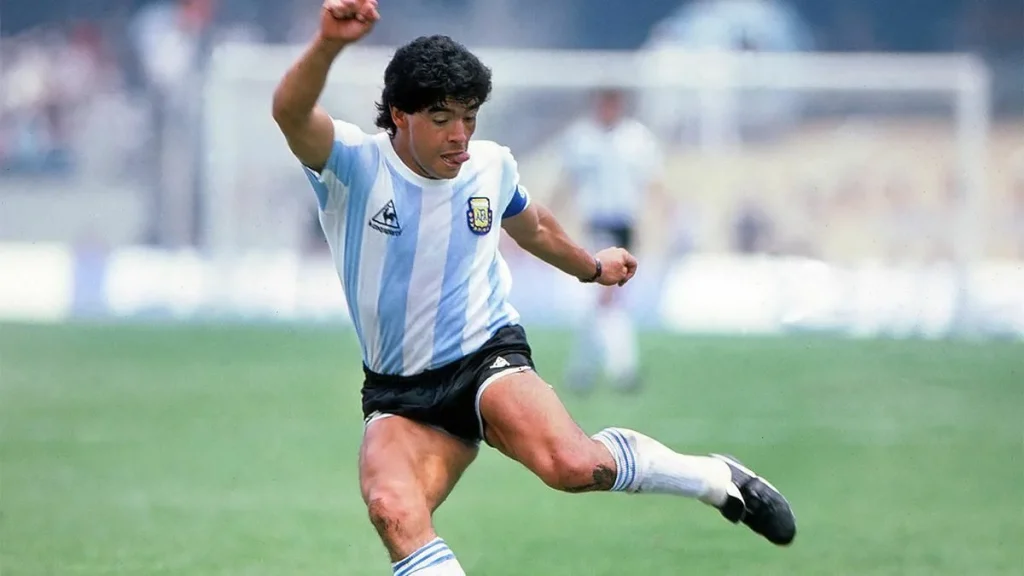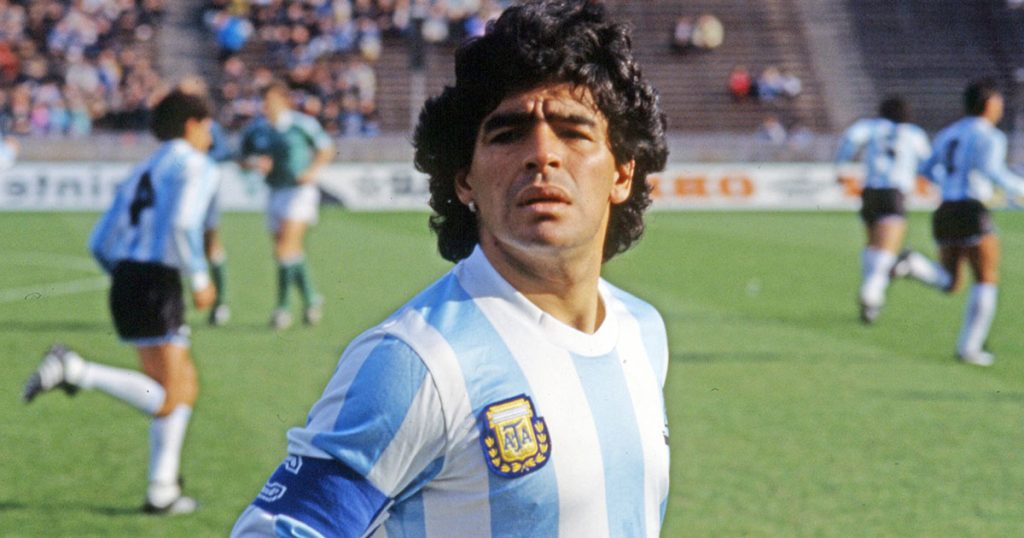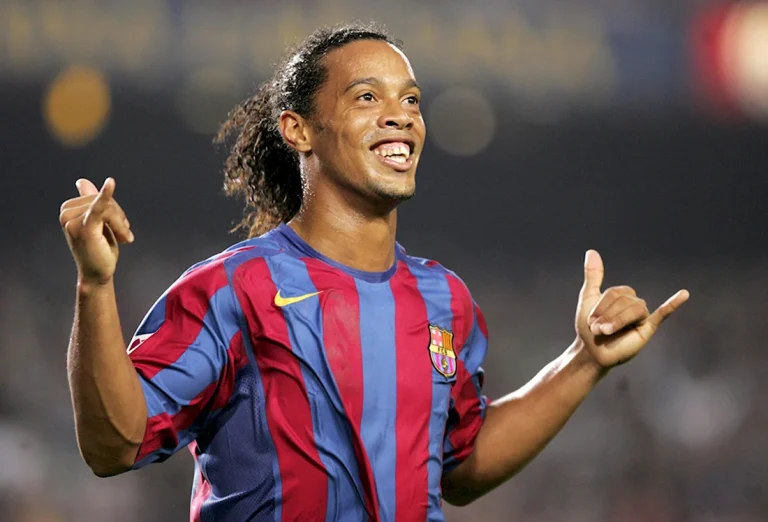Diego Maradona’s biography does not fit into standard formats; it is more like a five-act drama. Each episode not only revolutionized his career but also changed the perception of football as a whole. His rise from the Argentine slums, his dizzying triumphs, his downfalls, and his comebacks shaped the image of a player whose story has long transcended the boundaries of sports.
Diego Maradona’s Biography: A Childhood Without Gas or Gates
His career began on October 30, 1960, in Lanús, a southern suburb of Buenos Aires. A family of eight shared a shack without electricity or running water. Maradona was the fifth child in the row, but he was the first to sleep with a ball instead of toys. Football replaced survival school, and the street became his gym.
Already at the age of 9, “Gypsy” (El Pibe de Oro) signed his first contract with the Los Sebolitas youth team, scoring 136 goals in 141 matches. The first victory is not a title, but a chance to go beyond poverty.
Master of the Stage: Technique, Goals, and Half-Defense
 Diego Maradona’s biography gained momentum in 1976, when he made his debut for Argentinos Juniors. Over the next five years, he scored 116 goals in 166 games. In 1981, Boca Juniors acquired his services, and he became a lightning bolt on their field. A year later, Barcelona paid a world record-breaking \$7.6 million for his signature.
Diego Maradona’s biography gained momentum in 1976, when he made his debut for Argentinos Juniors. Over the next five years, he scored 116 goals in 166 games. In 1981, Boca Juniors acquired his services, and he became a lightning bolt on their field. A year later, Barcelona paid a world record-breaking \$7.6 million for his signature.
In Spain, Maradona transformed his position: he combined the functions of a midfielder and a striker, skillfully balancing between play and show. His game included instant dribbling, sharp passes, and shots from any distance. He executed penalties with the precision of a jeweler, converting 25 of his 28 attempts. During his two seasons with Barcelona, he scored 38 goals, won two trophies, and sustained three concussions due to constant collisions and fouls.
Naples: A Cult That Hasn’t Withered Away
Since 1984, his biography has been intertwined with the history of Napoli. For $10.48 million, the club acquired not just a player, but a symbol of hope. In 1987 and the 1990s, the team won the Italian championship for the first time in its history. Maradona lifted five trophies, including the UEFA Cup, becoming the captain and the heart of the city. In Naples, his image appeared on icons, and his name was written in prayers. To this day, Juventus fans avoid making eye contact when mentioning that team.
The “Hand of God” and the hand of the devil
The 1986 World Cup brought his career to a climax. Two goals in one match turned Diego Maradona into a mythological figure, straddling the line between genius and transgression. These moments etched his name in the annals of football as a symbol of contradiction and absolute mastery. In the quarter-final against England, two goals marked a turning point:
- The first goal was scored by a “God’s hand.” Was it a foul? Absolutely. Was it a genius? Undoubtedly.
- The second goal was a solo run from 60 meters, with five opponents beaten and the ball in the net.
Argentina won the cup, and Maradona received the Ballon d’Or. During the entire tournament, the player scored 5 goals and 5 assists.
Diego Maradona’s Biography: Numbers, Titles, and Details
Diego Maradona’s career includes 588 matches, 312 goals, 3 club championships, 1 world title, and 13 major awards. He played 91 games for the national team, scoring 34 goals. He also maintained a unique dribbling record, with 91% of successful dribbles in the 1986-1987 season.
Diego Maradona’s major achievements include:
- World Champion 1986.
- UEFA Cup 1989.
- Serie A Champion: 1987, 1990.
- Italian Cup 1987.
- FIFA Ballon d’Or (honorable) – 1995.
- Best Player of the World Cup – 1986.
- Inclusion in FIFA 100.
Each trophy captured not only a sporting achievement, but also a cultural shift—from a local hope to a global symbol of an era. His biography highlights that his achievements were not the result of effort, but rather a byproduct of his unique perception of the game.
More than a field: salaries and money
The financial trail has also become an integral part of Diego Maradona’s biography. At Napoli, he earned approximately \$3 million per year (including bonuses and advertising contracts). By 1991, his assets were estimated at \$25 million. However, after his retirement, he faced financial difficulties and legal disputes.
In 2005, the Italian tax authorities demanded €37 million from him. In 2013, authorities confiscated two gold earrings and a Swiss watch. A career as a coach in the UAE, Mexico, Argentina, and Belarus increased his income, but did not stabilize his finances. By the end of his life, his assets had not exceeded $1.5 million.
Addiction, scandals, rehabilitation
In 1991, the Buenos Aires police detected cocaine in the footballer’s system, marking the beginning of the first public scandal. A doping test after a match for Napoli confirmed the presence of prohibited substances. The Football Federation disqualified the footballer for 15 months.
After his return, he attempted to revive his career with Sevilla and Newell’s Old Boys, eventually retiring from professional football in 1997.
His addiction persisted until the end. In 2000, he underwent drug rehabilitation in Cuba, and later received treatment in Switzerland and Argentina. In 2004, he was hospitalized with a diagnosis of “cardiac arrhythmia due to an overdose.” He underwent six recovery courses until 2007.
A number of legal processes accompanied the fall. In 1994, an Italian court initiated a case for drug possession. In 2009, an Argentine court ordered the payment of child support for an illegitimate son. In total, the footballer was involved in four criminal and six civil cases, including disputes with the tax authorities, television channels, and former agents.
Diego Maradona’s Personal Life: Emotions, Children, and Confessions
In 1984, he married Claudia Villafaña, and they had two daughters, Dalmá and Giannina. Their divorce in 2003 ended their 19-year marriage. Later, he confirmed the paternity of five more children, including a son with Italian model Cristina Siniagra.
He officially acknowledged eight children. His relationship with his children was characterized by emotional instability. In a 2019 television interview, he clarified that he “recognizes everyone who is recognized by the law.”
The athlete’s personal life was constantly featured in the tabloids, from high-profile affairs to shocking statements. One notable incident was his legal dispute with former agent Guillermo Coppola.
The last days of Maradona’s life and the circumstances of his death
In 2020, a month before his death, the athlete underwent surgery to remove a brain hematoma. His recovery was accompanied by complications. On November 25, 2020, he passed away at home in Tigre, Argentina. The cause of death was chronic heart failure, exacerbated by alcohol and drug addiction.
Following his death, an investigation was launched against his doctor. Forensic experts accused the medical staff of negligence. The Argentine Ministry of Justice recorded “multiple violations of medical care.”
The Athlete’s Legacy
Football has preserved Maradona’s image as a living mythology. FIFA has included him in the list of the greatest players of the 20th century. In Argentina, the stadium “La Bombonera” was renamed in his honor. In 2021, the club “Napoli” added his name to the official name of the arena.
The Argentine national team still uses his game clips as training material for dribbling and technique. In 2020, the magazine “France Football” included him in the all-time team of the year. His football career is studied as a case study of the symbiosis of talent and destruction.
Diego Maradona’s Biography: Conclusions
 Diego Maradona’s biography captured not just a career, but a cultural phenomenon. His playing style shattered defenses, his character transcended boundaries, and his fame defied all limits. Football gained a figure who transcended the realm of sports. The 1986 victory, the “Hand of God” scandal, his battle with addiction, and his confrontation with the law—each aspect became part of the myth. His career was not a chronicle, but an odyssey of a genius on the brink.
Diego Maradona’s biography captured not just a career, but a cultural phenomenon. His playing style shattered defenses, his character transcended boundaries, and his fame defied all limits. Football gained a figure who transcended the realm of sports. The 1986 victory, the “Hand of God” scandal, his battle with addiction, and his confrontation with the law—each aspect became part of the myth. His career was not a chronicle, but an odyssey of a genius on the brink.













